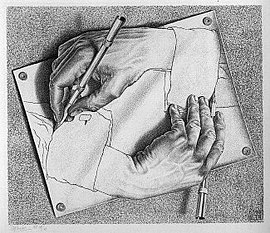Drawing Hands
| Drawing Hands | |
|---|---|
 Scanned from The Magic of M. C. Escher | |
| Artist | M. C. Escher |
| Year | 1948 |
| Medium | Lithograph |
| Dimensions | 28.2 cm × 33.2 cm (11.1 in × 13.1 in) |
| Preceded by | Up and Down (1947) |
| Followed by | Dewdrop (1948) |
| Website | Official website |

Drawing Hands is a lithograph by the Dutch artist M. C. Escher first printed in January 1948. It depicts a sheet of paper, out of which two hands rise, in the paradoxical act of drawing one another into existence. This is one of the most obvious examples of Escher's common use of paradox.
It is referenced in the book Gödel, Escher, Bach, by Douglas Hofstadter, who calls it an example of a strange loop. It is used in Structure and Interpretation of Computer Programs by Harold Abelson and Gerald Jay Sussman as an allegory for the eval and apply functions of programming language interpreters in computer science, which feed each other.
Drawing Hands has been referenced and copied many times by artists in different ways. In tech culture, robot hands draw or build each other,[1] or a human hand and robot hand draw each other.[2][3]
References
- ^ hygglobert (21 June 2011). Escher Robot Hands. Escher Remastered. FreakingNews (Digital illustration). Archived from the original on 28 May 2018. Retrieved 28 May 2018.
- ^ Rockhill, W. Morgan. Digital Photographic recreation of M. C. Escher drawing, robotic hands. Concept Photography (Photograph). Morgan Rockhill PhotoDigital. Archived from the original on 28 May 2018. Retrieved 28 May 2018.
- ^ Willis, Shane (12 October 2007). Hand Fixing Hand. Photo.net (Photograph). Archived from the original on 14 November 2016. Retrieved 28 May 2018."'Hand Fixing Hand', A Futuristic Take On M.C. Escher's Iconic 'Drawing Hands'". Geekologie. Anticlown Media. 1 November 2012. Archived from the original on 28 May 2018. Retrieved 28 May 2018.
Bibliography
- Locher, J. L. (2000). The Magic of M. C. Escher. Harry N. Abrams, Inc. ISBN 0-8109-6720-0.
